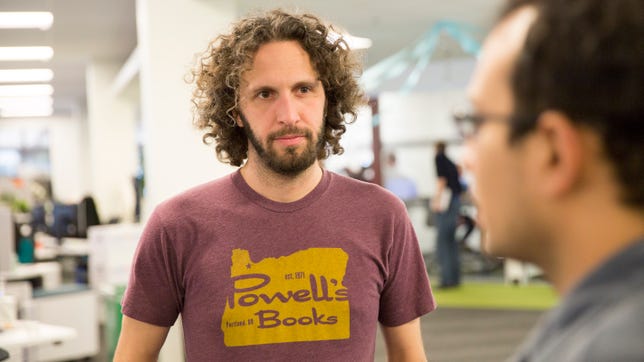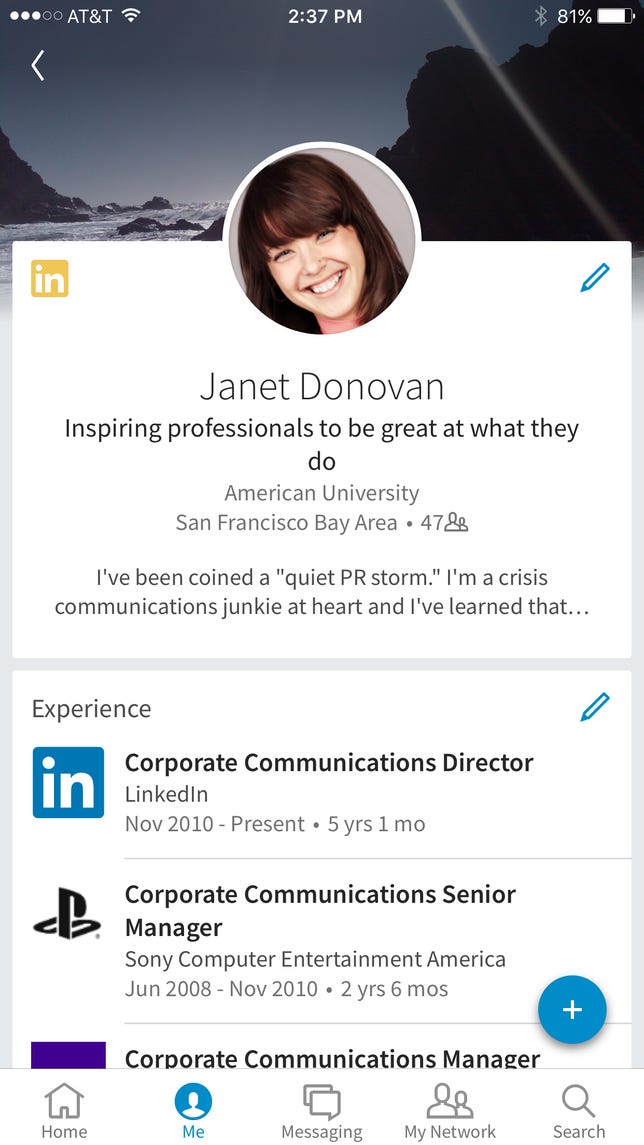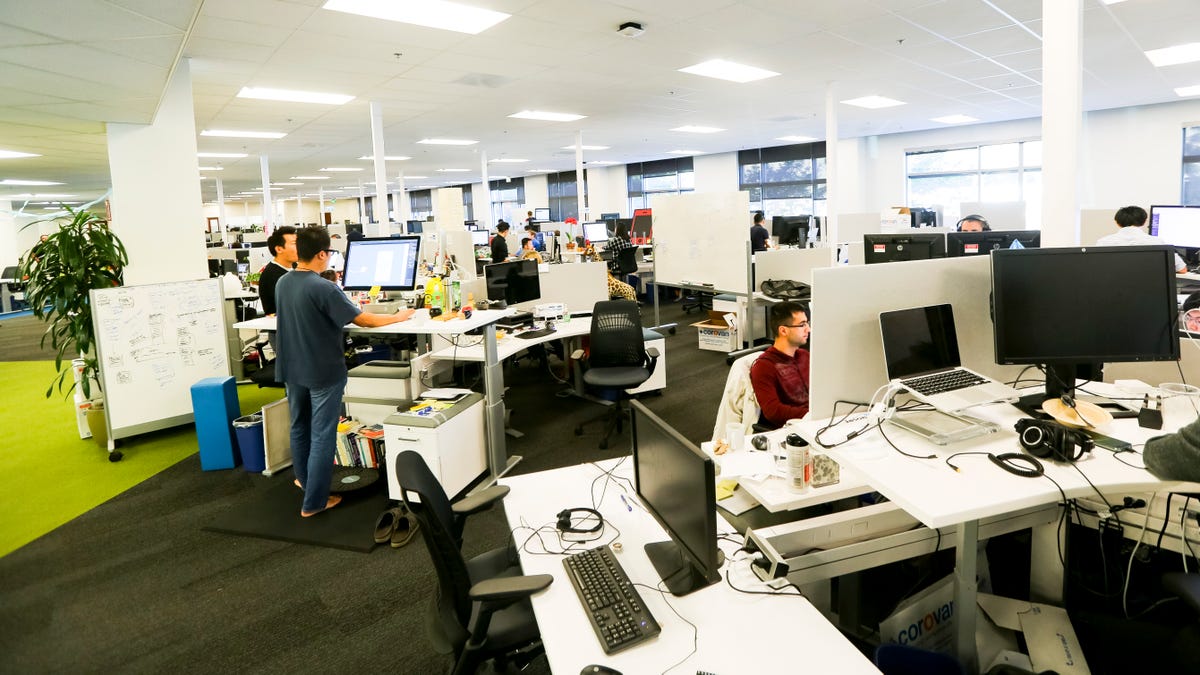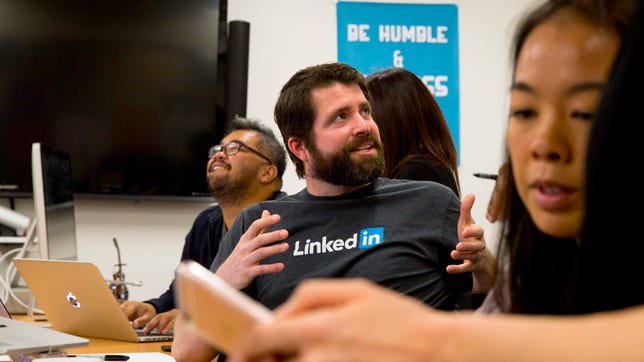MOUNTAIN VIEW, California — Nathan Hammond radiates fatigue. The bearded and tousle-haired engineer has clocked an average of 60 hours a week for four months working on the most important mobile app in LinkedIn’s history.
Though he moved to San Francisco from North Carolina earlier this year, Hammond hasn’t had time to explore his new digs. Instead, the user interface engineer has been laser-focused on the new app, codenamed Voyager. It’s intended to get you, me and millions of others to use LinkedIn more often, and he hopes it will work without a hitch when it’s released to the world Tuesday.
“It doesn’t matter if I’m here, at home or on the train — I’m working,” said Hammond, sitting at a mostly empty desk, with a laptop, phone, screens and empty bowl next to a box of Honey Nut Cheerios, on a recent Wednesday here at LinkedIn’s headquarters.
 Enlarge Image
Enlarge ImageLinkedIn engineer Nathan Hammond talks to a colleague about the company’s revamped app.
James Martin/CNET
It’s not an understatement to say that Hammond, along the 200 other engineers and designers working on the new app, has been on a long journey with Voyager, named after one of the most ambitious NASA exploration probes ever sent into space. Here on Earth, the project is a dramatic revamp of LinkedIn’s mobile app, which had been often criticized for being cluttered and difficult to navigate.
Voyager is key to LinkedIn’s future and Hammond’s peace of mind. It’s intended to be the primary way people use the 12-year-old social network — its “front door,” as they say. More than half of LinkedIn’s traffic comes from people checking in on a mobile phone or tablet, and it’s expected to rise even further. The company believes giving people a faster, more efficient way to use its services, which help them find jobs or just connect with others, will attract new users beyond the 400 million it currently boasts. (The social network is free to use, but charges for features like advanced search and messaging strangers. LinkedIn doesn’t say how many of its users pay.)

 Enlarge Image
Enlarge ImageOne of the new features in LinkedIn’s revamped app is called Me, where you can see who’s viewed your profiled, who’s commenting and who’s sharing your posts.
To do this, the app has a new look, ditching a former design that only offered a search bar, an ability to write posts a la Facebook and a news feed. There are now five buttons in a row on the bottom of the home page: Home, Me, Messages, My Network and Search. Home offers up news stories and items that LinkedIn thinks are most important to people and their networks, while the Me feature lets you put in more details about yourself as part of your personal branding. Messaging is intended for quick, casual banter.
‘A new LinkedIn emerging’
Voyager represents LinkedIn’s ambition to grow beyond its roots as a resume-on-the-Web service into the center of your workday. If it’s successful, you’ll think of it as an app for enhancing your professional life the way Facebook is meant to enhance your personal life, allowing you to share and stay in touch with friends and colleagues.
“This is more about a new LinkedIn emerging than it is about a new app,” Joff Redfern, LinkedIn’s vice president of product, said during a conversation inside a building that’s solely dedicated to building Voyager in the heart of the company’s sprawling Silicon Valley campus. (Yes, there’s also a massive cafeteria, where the food is free, and the cuisine is on par with a good, and expensive, restaurant in San Francisco.)
More than 4,000 LinkedIn employees tested Voyager before its official launch Tuesday night. It was also bullet-tested by people in locales as close as Chicago and as far away as India, where the social network is particularly popular. (The app was rewritten to suck less data from mobile plans, a nod to the older-generation wireless connections prevalent in that part of the world.)
LinkedIn CEO Jeff Weiner said Voyager is about “one app, developed by one team, with one vision.”
“When we set about to reimagine LinkedIn’s flagship app, we started by asking ourselves a single question: ‘What would we build if we could start all over?'” Weiner said in an email statement. “The answer was an app with greater focus on fewer things done better, seamlessly integrated; simpler, more personalized, and more responsive.”
Voyager also promotes LinkedIn’s other standalone services, including its news app, called Pulse, and Lynda.com, the online education site it purchased in April for $1.5 billion, its biggest acquisition to date.
LinkedIn feels the pressure to get it right, especially as people look to other social networks and services like Facebook to serve as their main point of contact with the rest of the world. The Voyager team was fine-tuning right up to the app’s global launch to make sure the right approvals were in place to work on Apple iOS and Google Android phones and tablets.
It makes sense for LinkedIn to hit the reset button on its main app, said John Jackson, vice president for mobile and connected platforms at market research firm IDC. “Whether it is LinkedIn, Facebook or Twitter, this is ultimately a fight for engagement to get more eyeballs looking at and using your product for long periods of time,” he said. “They are trying to own the professional graph, rather than the social graph.”


LinkedIn dedicated a whole football field-sized floor for some 200 engineers and designers remaking its flagship app. “One team, with one vision,” CEO Jeff Weiner says.
James Martin/CNET
Whiteboards filled with code
In early November, Building 7 at LinkedIn’s headquarters was abuzz with employees expressing equal parts activity and anxiety. The first floor is about the size of a football field, filled with pods of four desks each. Developers are working so intently that their heads are nearly pressed against their computer screens.

 Enlarge Image
Enlarge ImageThe message says it all as members of LinkedIn’s app team work feverishly on the rebuilt-from-scratch mobile product.
James Martin/CNET
Small groups sometimes gather in the open spaces, usually to discuss the app or what they’re eating for lunch — if there’s time.
Code-filled whiteboards are nearly everywhere. They’re on the walls, they’re on rollers, and they’re in the meeting rooms. The air in some parts of the building has a stale, round-the-clock feel. If crunch time had a smell, this would be it.
Nearly all the “war rooms,” where engineers and designers converge using whiteboards, laptops or flat screens, are filled for hours on end. One employee wrote in big bold letters on the glass: “DO NOT BOTHER US.” Sometimes as many as 40 people crammed inside a space that’s about the size of a dorm room.
In one war room, a team of engineers and designers surrounded a whiteboard with a grid of to-dos accompanied by smiley faces drawn by employees who’d finished their work. Messaging for Apple’s iOS 5 software: smiley face. Android: smiley face. iPad: blank.
A wall is adorned with colorful motivational posters, with phrases like “Screw it, let’s do it,” “Inspiration, aspiration and perspiration,” and “Be humble and kick ass!” It used to be filled with screen mockups and large sheets of code.

 Enlarge Image
Enlarge ImageJim Fell, a principal designer, has been growing a beard as a “badge of honor” from the day he started working on LinkedIn’s new mobile app.
James Martin/CNET
Jim Fell, a principal designer, started growing a woolly, dark-brown beard on the day he began work on Voyager more than four months ago. It’s his “badge of honor,” a symbol of the time and effort spent on the project. “I just let it go,” Fell said, remembering he once worked 36 hours straight during the early stages of designing the app along with members of the product and engineering teams. More than 100 features were considered before Voyager was pared down to 10 and then the final five.
“There was definitely a lot of arguing,” Fell recalled, while sitting in the war room that’s become like a second home. “You lose some battles for sure.”
Meanwhile, Hammond sees light at the end of the tunnel. He’s planning to explore more of San Francisco, which he hasn’t been able to do since his move west in March. Bleary-eyed and weary, Hammond feels the “aggressive timeline” to get the app out.
It’s all “a sheer force of will,” he said. “I’m excited…and exhausted.”
Correction, December 2, 11:22 a.m. PT: An earlier version of this story misquoted Jessica Clark, a LinkedIn designer. The misquote has been removed from this story.



